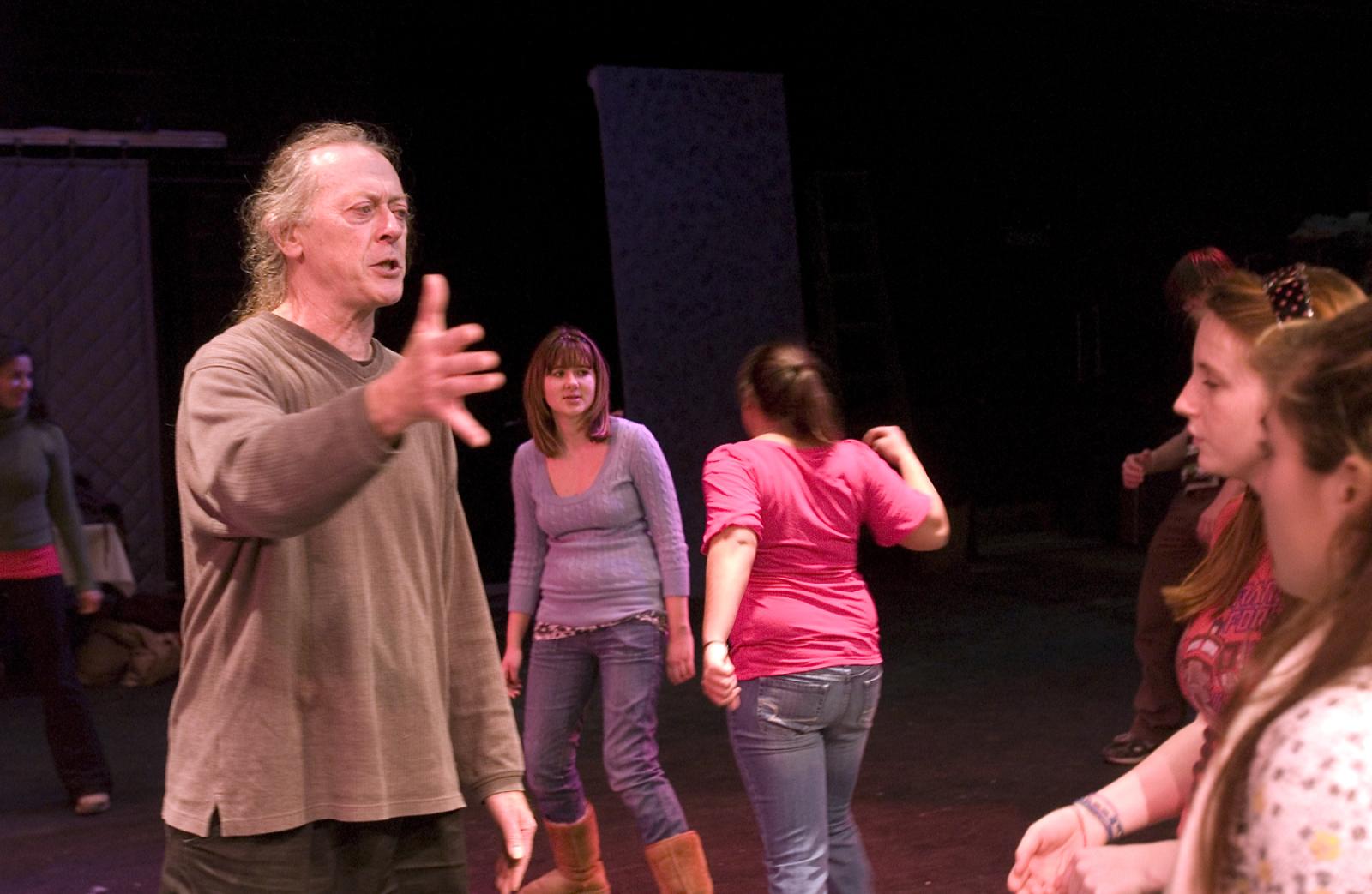Dudley Brooks sits cross-legged on the floor of room 405 at the regional high school, staring intently at two students in the center of the room. His eyes flicker back and forth between the performers, analyzing their movements with an expert, subtle gaze.
The scene ends and he leans forward, hands gesturing excitedly. “Okay, now do it again, but exaggerate it four times as much. Make it bigger. It should be a grotesque exaggeration of whatever your character is.” He sits back, chin resting on his hand, squinting as the students restart the scene, a snippet from You’re a Good Man, Charlie Brown, in which Linus and Lucy discuss the likelihood of her becoming a princess. This time, the students take their characters to the extreme. Lucy becomes comically grandiose and demanding, while Linus, a hooded sweatshirt standing in as his ubiquitous security blanket, ties himself in knots, long limbs snaking around in a ludicrous display of childlike discomfort and insecurity run amok. The room fills with laughter. Mr. Brooks’s eyes, still trained on the actors as they finish their scene, betrays an inward smile.
The students are members of the regional high drama department. They have an hour and a half with Mr. Brooks, Andrew Broaddus and Erica Hartono, all members of Run For Your Life . . . It’s a Dance Company, which last year won the competitive Yard Dance Company Residency grant, a paid residency at the historic Chilmark performing artists’ colony. Mr. Brooks, Run For Your Life’s artistic director, Mr. Broaddus, and Ms. Hartono returned to the Island this week as a part of the Yard’s Artists in the Schools, a long-standing program that brings world-class performers into Vineyard classrooms to share their knowledge and techniques with students from kindergarten to twelfth grade.
On Tuesday the performers were workshopping the basic skills of clowning, which as it turns out, is not all fun and games. “So much of clowning is based on diffusing things that aren’t actually very pleasant,” said Mr. Brooks. Mr. Broaddus, who studied dance at Oberlin College and since graduating in 2007 has performed as not only a dancer but as a juggler, clown and ringmaster, expands on the point. “Previously, my experience was at college, performing in a full gymnasium, in the round, and I was making all these exaggerations . . . but when I started working with Dudley, I learned that it’s really about minimalist, genuine reactions. You build your character out of your own personality, exaggerating your own idiosyncrasies, and then you let that persona carry the performance. Once you establish that character, then even the smallest things become funny. Life itself is just funny, and clowning is basically just an attitude,” he said.
In fact, becoming a clown involves real psychological exertion. For the first exercise of the day, students were asked to think of everything that anyone had ever told them about themselves, such as comments on their posture or way of talking, and then take those niggling insecurities and exaggerate them. By the end of the day’s workshop, students had received a lesson in how to pretend to trip and recover with realistic emotion. They also learned about the so-called knap during a short segment on stage combat. One student feigns a face slap, and the slapee snaps back at the neck while simultaneously clapping her hands together to create the illusion of actual contact. The timing and cooperation involved in making a convincing stage slap is considerable, but in this and throughout the workshop, the high school drama students proved to be quick studies.
“In all the schools we’ve visited, the kids have been phenomenal. It’s amazing,” said Ms. Hartono, after the bell rang on the first workshop.
Run For Your Life is not small potatoes; the troupe’s abstract comedic performances have delighted audiences and critics around the world, gaining considerable accolades along the way. “It’s unusual to find performers who are that skilled technically and, at the same time, have the acting skills to execute that kind of wit. You could liken it to the work of a Buster Keaton or a Charlie Chaplin,” said Yard executive director Wendy Taucher. “Dudley is interested in clowning and he knows quite a lot about it, but he is also a highly skilled artist who makes well-crafted work, and that is what the Yard is interested in, and that’s what the [Artists in the Schools] program brings to the community.”
Ms. Taucher has lined up a return visit for fight choreographer J. David Brimmer, a professor at NYU whose workshop last year was tremendously popular, and the Yard has an ongoing relationship with the Associação de Capoeira, a group that teaches a Brazilian system of physical discipline and movement that is part martial art, part high-intensity dance, for future workshops this year. And while the diversity and distinction of the performers involved with the Artists in the Schools program is impressive , Ms. Taucher said it’s not just about the artists; school staff and students are the ones who really make the program work. She singled out high school drama director Kate Murray for being instrumental in facilitating the program.
“She is doing great stuff. She’s terrific; she’s doing great things for the high school,” Ms. Taucher said.






Comments
Comment policy »